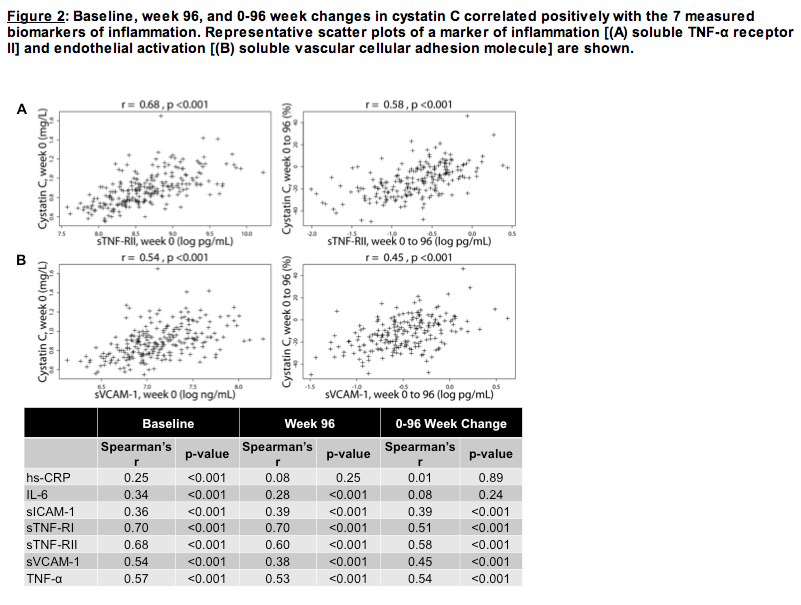 |
 |
 |
| |
Atazanavir and Tenofovir Attenuate the Benefit of Antiretroviral Therapy on Cystatin C: ACTG A5224s
|
| |
| |
Reported by Jules Levin
CROI 2014 March 3-6 Boston, MA
Chris T. Longenecker1,2, Douglas Kitch3, Paul Sax4,5, Eric S. Daar6, Camlin Tierney3, and Grace A. McComsey1,2
1 Case Western Reserve University School of Medicine; Cleveland, OH, USA; 2 University Hospitals Case Medical Center; Cleveland, OH, USA; 3 Harvard School of Public Health; Boston, MA, USA;
4 Harvard Medical School; Boston, MA, USA; 5 Brigham and Women's Hospital; Boston, MA, USA; 6 Los Angeles Biomedical Research Institute at Harbor-UCLA Medical Center; Torrance, CA, USA

Program Abstract-
Background: Plasma cystatin C is a biomarker of kidney function thought to more accurately reflect glomerular filtration rate (GFR)
than serum creatinine. Whether inflammation affects cystatin C concentrations is controversial. The differential effects of antiretroviral therapy
(ART) on cystatin C are poorly understood.
Methodology: ACTG A5224s was a substudy of A5202 which randomly assigned 1857 ART-naïve HIV-infected adults to blinded
abacavir/lamivudine (ABC/3TC) or tenofovir/emtricitabine (TDF/FTC) with open-label efavirenz (EFV) or atazanavir/ritonavir (ATV/r).
The factorial design was analyzed with one and two-sample t-tests and multivariable linear regression was used to analyze changes in plasma
cystatin C from 0 to 96 weeks. Spearman correlations were used to analyze baseline and change relationships between cystatin C and
biomarkers of inflammation.
Results: Of 269 substudy participants, 85% were male and 66% White non-Hispanics; baseline mean(standard deviation)
CD4 count was 236(165) cells/mm3 and cystatin C level 0.89(0.17) mg/L. On average, cystatin C decreased significantly over 96 weeks
within each arm (pē0.003). ATV/r and TDF/ FTC use were each associated with significant or marginally significant attenuation of the
beneficial effects of ART on cystatin C (Figure, no evidence of treatment interaction). In a multivariable regression model, higher baseline HIV-1 RNA,
assignment to ABC/3TC, and to EFV were independently associated (p<0.05) with greater % decreases in cystatin C.
At baseline, cystatin C was positively correlated with biomarkers of inflammation and endothelial activation: high sensitivity C-reactive protein (r=0.25),
interleukin-6 (r=0.34), soluble intercellular adhesion molecule (r=0.36), soluble vascular cell adhesion molecule (r=0.54), tumor necrosis factor-α (r=0.57),
and soluble TNF-α receptor-I (r=0.70, all p<0.001). Reductions in cystatin C from 0 to 96 weeks correlated with reductions in inflammatory biomarkers
(r=0.39 to 0.58, p<0.001) except for hsCRP (p=0.89) and IL-6 (p=0.24).
Conclusions: The beneficial effect of initiating ART on kidney function as measured by plasma cystatin C levels is attenuated by boosted
ATV and TDF/FTC when compared to EFV and ABC/3TC containing regimens, respectively. Decreases in plasma cystatin C after ART initiation
may result from improved GFR, but may also be due to decreased systemic inflammation.







|
| |
|
 |
 |
|
|